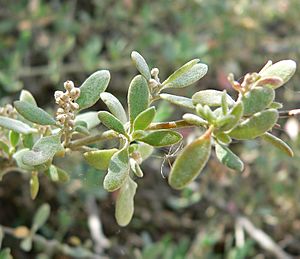Chenopodium spinescens facts for kids
Quick facts for kids Chenopodium spinescens |
|
|---|---|
| From Mueller (1889) | |
 |
|
| Foliage | |
| Conservation status | |
|
LC (TPWCA)
|
|
| Scientific classification | |
| Genus: |
Chenopodium
|
| Species: |
spinescens
|
 |
|
| Occurrence data from AVH | |
| Synonyms | |
Chenopodium spinescens, also known as spiny saltbush or berry saltbush, is a special plant found only in Australia. It belongs to the Amaranthaceae plant family. You can find this plant in almost every state and territory in Australia, except for Tasmania.
Contents
What Does It Look Like?
Chenopodium spinescens is a bushy plant that can grow up to 2 metres (7 ft) tall. It has many stems, and often the ends of its branches are spiky.
Leaves
The leaves of this plant can grow opposite each other or one after another along the stem. They look grey-green or almost white because they are covered in tiny, saucer-shaped hairs. The leaves are shaped like an egg or a triangle. They are usually 5–17 millimetres (0.2–0.7 in) long and 5–17 millimetres (0.2–0.7 in) wide. The stalk that connects the leaf to the stem is about half the length of the leaf itself.
Flowers and Fruit
This plant usually has male and female flowers on different plants. The flowers are tiny and have five similar parts. Male flowers are round and very small, about 0.5 to 1 mm across. Female flowers are a bit bigger, about 1 mm, and can be round or top-shaped.
When the plant produces fruit, they are round, juicy berries that are pink or red. Inside, the seed is about 1 millimetre (0.04 in) wide and has a net-like pattern on its surface.
In the Northern Territory, you can see this plant flowering and fruiting from February to December. In Victoria, it flowers from January to April.
How It Was Named
The plant Chenopodium spinescens was first described in 1810 by a botanist named Robert Brown. He first called it Rhagodia spinescens. His description was published in a book called Prodromus Florae Novae Hollandiae et Insulae Van Diemen.
Later, in 2012, two scientists, Susy Fuentes Bazán and Thomas Borsch, decided that all plants in the Rhagodia group should actually be moved into the Chenopodium group. This change was accepted by many experts. However, some groups, like the Council of Heads of Australasian Herbaria (CHAH), still prefer to use the older names, Rhagodia for the genus and Chenopodiaceae for the family.
Where It Lives
This plant likes to grow in certain types of places, which is called its habitat.
In the Northern Territory, you can find it on flat sandy areas, floodplains, and sometimes along sandy riverbeds that dry up. It also grows on the sandy edges of salt lakes and, less often, on gravelly hillsides.
In Victoria, it usually grows in heavy, salty, or slightly salty soils. You can find it at the edges of lakes, on flat lands, and in the dips between sand dunes.
Where It Is Found
Chenopodium spinescens is found across many different natural regions in Australia. These regions include places like Burt Plain, Central Ranges, Channel Country, Coolgardie, Finke, Flinders Lofty Block, Gawler, Great Sandy Desert, Great Victoria Desert, MacDonnell Ranges, Mitchell Grass Downs, Nullarbor, Riverina, Simpson Strzelecki Dunefields, Stony Plains, and Tanami.
How to Grow New Plants
If you want to grow new Chenopodium spinescens plants, here's how you can do it:
- Take soft, new growth tips from healthy, actively growing plants.
- Wrap these cuttings in wet newspaper and seal them in a plastic bag to keep them fresh while you transport them.
- When you're ready to plant, trim the cuttings to be about 5–10 centimetres (2.0–3.9 in) long.
- Dip the trimmed end of each cutting into a special plant hormone (called IBA rooting hormone, at 3000 ppm) to help them grow roots.

